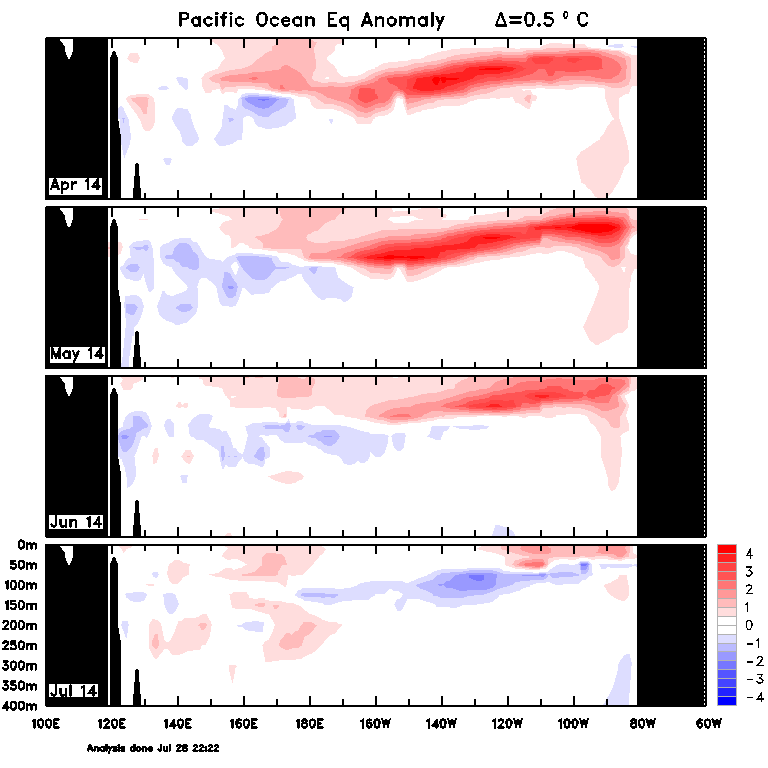Earlier this year the media were overflowing with reports about how a “super El Niño” was shaping up and that it could be a powerful one, so powerful in fact that it would make 2015 “very likely to become the hottest year on record by far.” Read for example posts by noted climate end-of-world theorists/cheerleaders Joe Romm, Andrew Freedman, Stefan Rahmstorf, Live Science…
Today German blog site Die kalte Sonn here brings us up to speed on the “super El Niño” topic. To sum it up, once again predictions by leading “experts” have turned out to be completely wrong. Call it climate false-alarmism.
=============================
Australian Meteorological Institute sees little chance of an El Nino in 2014
By Frank Bosse
(Translated, edited by P Gosselin)
In mid May we reported here on developments in the tropical Pacific and directed attention to a possible El Niño, but left out the use of vocabulary such as “wreak”, “catastrophe” and “chaos”. But other German media outlets didn’t hold back:
Focus 24 February 2014: Global climate problem: Floods, hurricanes, droughts– this is what El Niño has done
FAZ am 12 May 2014: Warming and weather chaos: “El Niño” is taking off
Neue Zürcher Zeitung: «El Niño» could lead to chaos
And also one or the other followers of alarmism were hoping the heat from the ocean would finally end the observed global temperature stagnation.
Already in early June 2014 we warned here at our blog that the probability of an El Niño was less than what the models had been projecting. On 29 July 2014 the Australian Meteorological Institute announced at their website that the probability of an El Nino developing in the near future was greatly reduced:
EL NINO INDICATORS EASE
Despite the tropical Pacific Ocean being primed for an El Niño during much of the first half of 2014, the atmosphere above has largely failed to respond, and hence the ocean and atmosphere have not reinforced each other. As a result, some cooling has now taken place in the central and eastern tropical Pacific Ocean, with most of the key NINO regions returning to neutral values. While the chance of an El Niño in 2014 has clearly eased, warmer-than-average waters persist in parts of the tropical Pacific, and the (slight) majority of climate models suggest El Niño remains likely for spring. Hence the establishment of El Niño before year’s end cannot be ruled out. If an El Niño were to occur, it is increasingly unlikely to be a strong event. Given the current observations and the climate model outlooks, the Bureau’s ENSO Tracker has shifted to El Niño WATCH status. This means the chance of El Niño developing in 2014 is approximately 50%, which remains significant at double the normal likelihood of an event. El Niño is often associated with wide scale below-average rainfall over southern and eastern inland areas of Australia and above-average daytime temperatures over southern Australia. Similar impacts prior to the event becoming fully established regularly occur. The Indian Ocean Dipole (IOD) index has been below −0.4 °C (the negative IOD threshold) since mid-June, but needs to remain negative into August to be considered an event. Model outlooks suggest this negative IOD is likely to be short lived, and return to neutral by spring. A negative IOD pattern typically brings wetter winter and spring conditions to inland and southern Australia.
The “missing heat” (as the temperatures have stood still since the start of our new millennium and thus are no longer in harmony with the pretty models…) now also appears nowhere to be found in the water. Keep searching!

Figure: The eastern Pacific has cooled over the last month. Bad news for the El Nino. Source: bom.gov.au





By hoping that an El Niño weather pattern is significant as far as warming is concerned, is significant in itself. By stating this they are admitting that natural variation can be more significant than an increase in co2. And if a high warming did occur (which I agree is unlikely) then it would be inconsistent of them to blame that on CO2.
Indeed. Pacific currents don’t produce heat, they just move pre-existing heat to the surface or away from the surface. No rational mechanism could be imagined by which CO2 concentrations in the atmosphere could trigger El Nino oceanic currents.
Had to kick our second fire into action today, our coldest day for the winter, and for some years I suspect, here in Victoria. A couple of examples, be advised of course it’s weather not climate, as we know it’s only climate when it’s a record High.
-7.2 MOUNT HOTHAM Upper NE VIC
-6.7 FALLS CREEK Upper NE VIC
-5.9 MOUNT BULLER Upper NE VIC
The El Nino hype is is subsiding somewhat, it seems there may be a minor event but probably nothing like what the alarmists had been hoping for.
The collapse of the SOI in April/May predicted it.
I would not recommend holding your breath for the admission of false alarmism from any of the sources.
Excellent article, thanks.
Just a reminder of history, when the PDO is in its negative phase the el Ninos tend to be weaker and rarer. La Ninas predominate.
el Nino numbers vs PDO phase
The reverse is true in the upswing of the PDO, when you get more el Ninos, including big ones.
This phase will continue for another 20 years, since the period of the cycle is about 60 years. You can also see the ~60 year cycle in the smoothed ENSO index data although its clearer in longer datasets like HadCRUT 3v and the AMO.